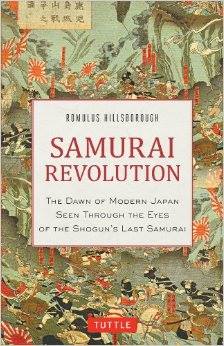
This is the story of the samurai revolution that spanned the third quarter of the nineteenth century. It transformed Japan from a country of hundreds of feudal domains under the hegemony of the Tokugawa Shogun, into a modern industrialized world power under the unifying rule of the Emperor. The shogun was head of the ruling Tokugawa family, and his regime was known as the Tokugawa Bakufu (Bakufu, for short).The first chapter of Samurai Revolution opens with the arrival of American warships commanded by Commodore Matthew Perry in 1853, sparking the revolution that would end with the fall of the Bakufu in 1868. The last chapter ends with the crushing defeat in 1877 of an army of former samurai who stood against the Imperial government they had created, marking the end of the samurai era, and with it the last vestiges of feudal Japan.
The series of tumultuous events between 1853 and 1868 are collectively called the Meiji Restoration (i.e., the restoration of Imperial rule). The Meiji Restoration was Japan’s modern revolution. It was different from other great revolutions in that it was brought about by men of the ruling caste—i.e., samurai. It is a human drama of epic proportion, which is how it is presented in Samurai Revolution. And just as the Meiji Restoration was “the dawn of modern Japan,” knowledge of this history is essential for understanding the complexities of today’s Japan.
The overthrow of the Bakufu in 1868 sparked a contained civil war that would have spread throughout the country, endangering Japan’s sovereignty, had Katsu Kaishu, as commander in chief of the fallen shogun’s still formidable military, not negotiated an eleventh-hour peace with Saigo Takamori, commander of the Imperial Army.
While Katsu Kaishu is a household name in Japan, Samurai Revolution, based largely on primary sources,including Kaishu’s journals and memoirs, is the first comprehensive English-language treatment of the man’s life, mind, and important role in the Meiji Restoration. In telling this history from the perspective of Katsu Kaishu, commissioner of the shogun’s navy and later supreme commander of the Tokugawa military, Hillsborough also portrays an array of other leading players in the Meiji Restoration drama – examining their values and social systems, their culture and ideals, their desires and fears, and their historical perspectives – against a backdrop of tumultuous events that would change their world forever.
Samurai Revolution, at 608 pages, is the first English-language presentation and analyses of these powerful and alluring personalities in one volume aimed at a general international audience.
Samurai Revolution “is one of only a small number of books in the English language that gives a true and authentic account of Japanese history.” Tsutomu Ohshima, Chief Instructor, Shotokan Karate of America
“We found it to be not only an excellent biography of Katsu, but an exceedingly well-done, intricate, and clearly written overview of this vital period of Japanese history.” Samurai Archives
“…Samurai Revolution serves as a compelling and timely warning for America today. Hillsborough astutely captures the serious consequences of self-imposed isolation, xenophobia and failure to adapt to the changing world.” Major Christopher J. Heatherly, Armchair General
“Hillsborough has produced a very readable account of this complex period, and his in-depth knowledge of Japan helps the reader understand the complexities of the issues involved and the difficulties faced by Japan’s leaders in a time of unexpected change.” historyofwar.org
